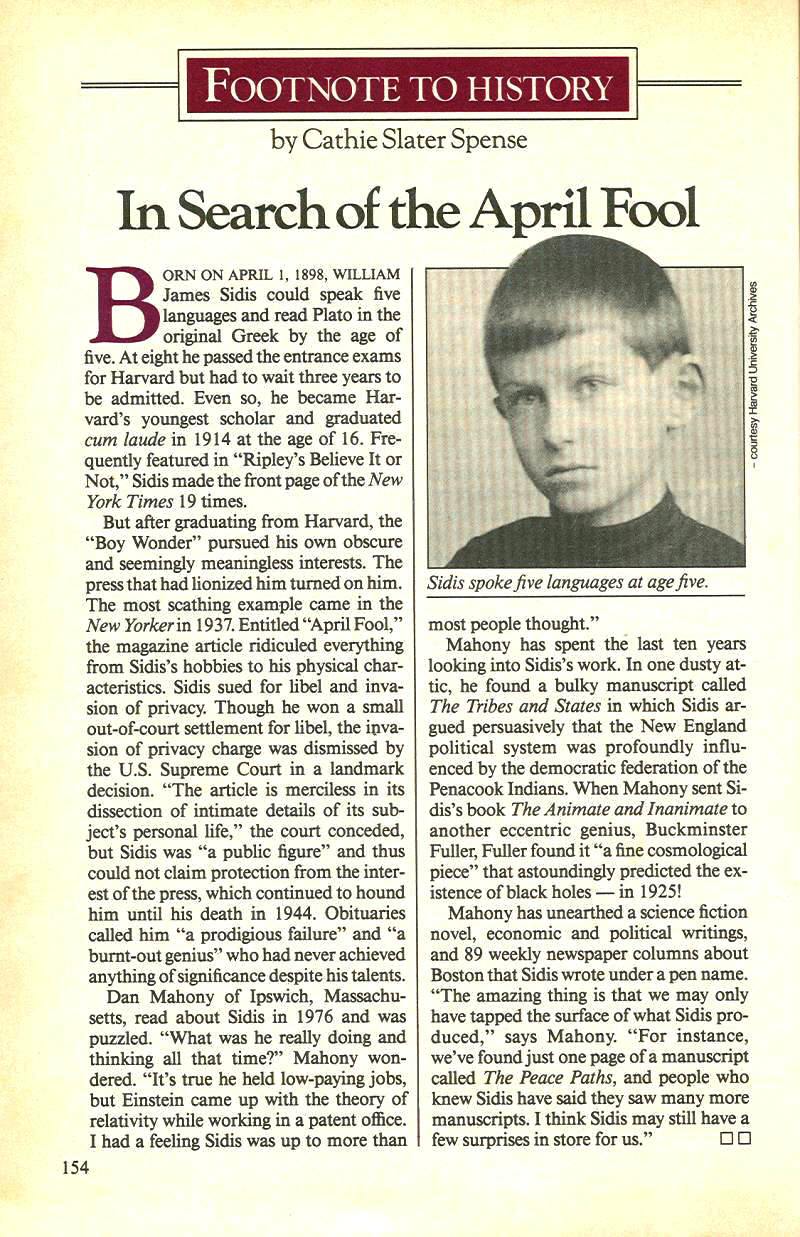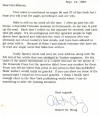|
(page 140) So although modern physics pulled the rug out from under the deterministic explanation of evolution many decades ago, it has survived by default because no other more plausible explanation has been available. But right from the beginning, substance-caused evolution has always had a puzzling aspect that it has never been able to eliminate. It goes into many volumes about how the fittest survive but never once answers the question of why. This is the sort of irrelevant-sounding question that seems minor at first, and the mind looks for a quick answer to dismiss it. It sounds like one of those hostile, ignorant questions some fundamentalist preacher might think up. But why do the fittest survive? Why does any life survive? It's illogical. It's self-contradictory that life should survive. If life is strictly a result of the physical and chemical forces of nature then why is life opposed to these same forces in its struggle to survive? Either life is with physical nature or it's against it. If it's with nature there's nothing to survive. If it's against physical nature then there must be something apart from the physical and chemical forces of nature that is motivating it to be against physical nature. The Second Law of Thermodynamics states that all energy systems "run down" like a clock and never rewind themselves. But life not only "runs up," converting low energy sea-water, sunlight and air into high-energy chemicals, it keeps multiplying itself into more and better clocks that keep "running up" faster and faster. Why, for example, should a group of simple, stable compounds of carbon, hydrogen, oxygen and nitrogen struggle for billions of years to organize themselves into a professor of chemistry? What's the motive? If we leave a chemistry professor out on a rock in the sun long enough the forces of nature will convert him into simple compounds of carbon, oxygen, hydrogen and nitrogen, calcium, phosphorus, and small amounts of other minerals. It's a one-way reaction. No matter what kind of chemistry professor we use and no matter what process we use we can't turn these compounds back into a chemistry professor. Chemistry professors are unstable mixtures of predominantly unstable compounds which, in the exclusive presence of the sun's heat, decay irreversibly into simpler organic and inorganic compounds. That's a scientific fact. The question is: Then why does nature reverse this process? What on earth causes the inorganic compounds to go the other way? It isn't sun's energy. We just saw what the sun's energy did. It has to something else. What is it? Nowhere on the pages of all that he had read about evolution did Phaedrus see any answer. He knew of theological answers, of course, but these aren't supported by scientific observation. Evolutionists, in their reply, simply say that in the scientific observation of the facts of the universe no goal or pattern has ever appeared toward which is heading. This last statement so neatly sweeps the whole matter under the carpet one would never guess that it was of much concern to evolutionists at all. But a reading of the early history of the theories of evolution shows this is not true. The first major evolutionist, who was not Darwin but Jean Baptiste Lamarck, maintained that all life was evolving toward perfection, a synonym for Quality. Alfred Wallace, who forced Darwin to publish by independently arriving at an almost identical theory, also maintained that natural selection was not enough account for the development of man. After Darwin many others continued to deny the goallessness of life. ------------ (page 203) "Phaedrus thought about William James Sidis, the prodigy who read five languages when he was five years old. After discovering what he had said about Indians, Phaedrus had read a full biography and found that when Sidis was a teenager he announced he would refuse to have anything to do with sex for the rest of his life. It seemed as though in order to sustain a satisfactory intellectual life he had to cut himself off from social and biological domination except where they were absolutely necessary. This vow of ancient priests and ascetics was once considered a high form of morality, but in the "Roaring Twenties" of the twentieth century a new standard of morals had arrived, and when journalists found out about this vow they ridiculed Sidis mercilessly. That coincided with the beginning of seclusion that lasted the rest of his life. "Is it better to have wisdom or is it better to be attractive to the ladies?" This was a question debated by Provençal poets way back thirteenth century. Sidis opted for wisdom, but it seemed to Phaedrus there ought to be some way you could have both. ------------ (page 408) The experience of William James Sidis had shown that you can't just tell people about Indians and expect them to listen. They already know about Indians. Their cup of tea is full. The cultural immune system will keep them from hearing anything else. Phaedrus hoped this Quality metaphysics was something that would get past the immune system and show that American Indian mysticism is not something alien from American culture. It's a deep submerged hidden root of it. Americans don't have to go to the Orient to learn what this mysticism stuff is about. In the Orient they dress it up with rituals and incense and pagodas and chants and, of course, huge organizational enterprises that bring in the equivalent of millions of dollars every year. American Indians haven't done this. Their way is to not be organized at all. They don't change anything, they don't make a big fuss, and that's what makes people underrate them. --------- (page 55) Back down in the plains, in a country motel one night with nothing to read, Phaedrus had found a small dog-eared Yankee magazine, thumbed through it, and stopped on a brief account by Cathie Slater Spence entitled, "In Search of the April Fool." It was about a child prodigy who had possibly the highest intelligence ever observed, and who in his later life went nowhere. "Born on April 1, 1898," it said, "William James Sidis could speak five languages and read Plato in the original Greek by the age of five. At eight he passed the entrance for Harvard but had to wait three years to be admitted. Even so he became Harvard's youngest scholar and graduated cum laude in 1914 at the age of 16. Frequently featured in 'Ripley's Believe It or Not,' Sidis made the front page of the New York Times 19 times." But after graduating from Harvard, the "Boy Wonder" pursued his own obscure and seemingly meaningless interests. The press that had lionized him turned on him. The most scathing example came in the New Yorker in 1937. Entitled 'April Fool" the magazine article ridiculed everything from Sidis's hobbies to his physical characteristics. Sidis sued for libel and invasion of privacy. Though he won a small out-of-court settlement for libel, the invasion of privacy charge was dismissed by the U.S. Supreme Court in a landmark decision. "The article is merciless in its dissection of intimate details of its subject's personal life;" the court conceded, but Sidis was "a public figure" and thus could not claim protection from the interest of the press, which continued to hound him until his death in 1944. Obituaries called him "a prodigious failure" and "a burnt-out genius" who had never achieved anything of significance despite his talents. Dan Mahony of Ipswich, Massachusetts, read about Sidis in 1976 and was puzzled. "What was he really doing and thinking all that time?" Mahony wondered. "It's true he held low-paying jobs, but Einstein came up with the theory of relativity while working in a patent office. I had a feeling Sidis was up to more than most people thought." Mahony has spent the last ten years looking into Sidis's work. in one dusty attic, he found a bulky manuscript called 'The Tribes and the States' in which Sidis argues persuasively that the New England political system was profoundly influenced by the democratic federation of the Penacook Indians. At this sentence, a kind of shock passed through Phaedrus, but the article went on. When Mahony sent Sidis's book The Animate and Inanimate to another eccentric genius, Buckminster Fuller, Fuller found it "a fine cosmological piece" that astoundingly predicted the existence of black holes ―in 1925! Mahony has unearthed a science fiction novel economic,
and political writings, and 89 weekly newspaper columns about Boston that
Sidis wrote under a pen name. "The amazing thing is that we may only
have tapped the surface of what Sidis produced," says Mahony. "For
instance, we've found just one page of a manuscript called The Peace Paths,
and people who knew Sidis have said they saw many more manuscripts. I think
Sidis may still have a few surprises in store for us Phaedrus set down the magazine and felt as though someone had thrown a rock through the motel window. Then he read the article over and over again in a sort of daze, as the impact of what he was reading sank deeper and deeper. That night he could hardly sleep. It looked as though way back in the thirties Sidis had been on exactly the same thesis about Indians. He was trying to tell people some of the most important things that could be said about their country and they were rewarding him by publicly calling him a "fool" and failing to publish what he had written. There didn't even seem to be any way to find out what Sidis had said. Phaedrus tried to contact the Mahony mentioned in the article but couldn't find him, partly, he supposed, because his effort was only half-hearted. He knew that even if he did get a look at Sidis' material there wasn't much he could do about it. The problem wasn't that it wasn't true. The problem was that nobody was interested.
© 1991 by Robert M. Pirsig
|



